What’s Better: Traveling by Bus or Car?
Aeinna Kumar | March 8, 2025


While traveling by car offers more scheduling flexibility and privacy than traveling by bus, there are also many benefits to traveling by bus that at times can make it the preferred travel mode. Traveling by bus instead of by car can be more affordable, better for the environment and results in less traffic. I am a college student in Madison. I used the Madison bus when starting college in 2022 because I had no other ride option. It was a good experience. Although I later got a driver license and car, and started driving to college, I will never forget the experience of traveling by bus. That included walking about 1.2 miles from my home to the bus stop. While driving can be convenient because you can travel on your own schedule, using the bus teaches patience and can be the reason to wake up and get out of the house to do something every day. Using the bus helped me realize what I am working hard for and helped motivate me to achieve my goals. Overall, I had a great experience with Madison buses. Traveling by bus instead of by car can be more affordable. Not only is one bus ticket good for 2 hours in any direction (enabling a whole roundtrip ride if you go and return within 2 hours) but commuters save money on gas -- an average of at least $40-50 a week depending on vehicle type and distance traveled. They save money and/or time on parking since public transit riders don't need to pay for parking or spend time looking for a parking spot. And they save money on car insurance, potentially thousands of dollars yearly if they commute. Lastly, they save on maintenance costs, on average about a thousand dollars a year. Together, the cost of commuting by car instead of by public transit can be an average of $10-12 thousand dollars yearly. Local buses are also great for economic development and job creation, lower unemployment and connecting people to job opportunities (good for local employees more than travelers). Buses connect people to brands and companies through advertisements. Public transit creates jobs for bus drivers, office workers, and maintenance support personnel. It helps create job opportunities around our community. Bus travel can also be more environmentally friendly, more convenient for long distances, and causes less traffic congestion. By letting someone else drive, you can relax. By carrying multiple passengers in a single vehicle, there is less traffic. When there is so much going on in everyone’s life today, riding the bus instead of driving a car helps make life a little easier. Riding the bus instead of driving a car is a tradeoff however, and some may opt to drive despite the benefits of using the bus. For instance, is saving money worth having to walk for 20-30 minutes to a bus stop? What about such factors as scheduling flexibility, destination accessibility, or the quality of the bus service? There are many compromises an individual must make. Perhaps most important is that people be able to choose what they think is best for themselves. |